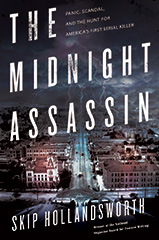Skip Hollandsworth’s Texas Tales: From Closets to Crime
Skip Hollandsworth, in his nearly 30 years of writing, has chronicled the best and worst of the Lone Star State.
Skip Hollandsworth’s Texas Tales: From Closets to Crime
Skip Hollandsworth, in his nearly 30 years of writing, has chronicled the best and worst of the Lone Star State.

W.N. “Skip” Hollandsworth ’79 is an award-winning journalist and best-selling author who captivates readers with the macabre. Photo by Carolyn Cruz
The picture next to the obituary showed a young man in a football uniform, his head cocked to the side as he grinned at the camera.
“That’s the most handsome teenage boy I’ve ever seen,” Shannon Hollandsworth said, handing the newspaper to her husband, W. N. “Skip” Hollandsworth ’79.
Hollandsworth read the first paragraph: “John McClamrock was the captain of the Hillcrest High School football team. On Oct. 17, 1973, while playing football, John’s neck was broken. With the constant and loving care from his mother and brother he lived the last 34 years as a quadriplegic. John’s amazing love for life outshined his disability.”
Setting down his coffee cup, Hollandsworth looked up the family’s address, which was mere blocks from his own home. That afternoon Hollandsworth put on a sports coat and drove to the McClamrocks’ modest home.
McClamrock’s mother, Ann, and brother, Henry, invited the journalist inside, where family and friends gathered.
In the following weeks, Hollandsworth returned to the McClamrock’s home several times to visit with Ann, a devout Catholic who had prayed every day to outlive her son. Two months after his funeral, she died at 89.
Hollandsworth continued to talk with Henry, to read books about life as a quadriplegic, and to talk with the friends who visited McClamrock while he lay in bed for three decades.
After nine months of research, Hollandsworth wrote the story “Still Life,” which was published in Texas Monthly in May 2009. The next year, the article won the magazine its first National Magazine Award for Feature Writing.
“It was luck, on the one hand, that he lived right there,” Hollandsworth said. “And it was instinct that comes from years of doing this. And was also knowing when to pull your car over and knock, unannounced, on someone’s front door.”
“Still Life” is one of hundreds of stories Hollandsworth has written during his nearly 30-year career at Texas Monthly, where he is an executive editor.
Often recognized for his true-crime journalism, Hollandsworth wrote the 1998 article that became the basis for the Richard Linklater film Bernie, for which he co-wrote the screenplay.

Hollandsworth’s best-selling book, which chronicles a series of killings in 19th century Austin, was released in paperback in April. Jacket design by David Shoemaker
The paperback edition of his best-selling book, The Midnight Assassin: Panic, Scandal, and the Hunt for America’s First Serial Killer (Henry Holt, 2016), which chronicles a series of brutal killings in 19th-century Austin, came out in April 2016.
Growing Up: Church and Cello
The son of a Presbyterian minister, Hollandsworth was reared in Wichita Falls, Texas, where life revolved around Sunday church and Wednesday night fellowship dinners. He excelled at the cello – “I was the Yo-Yo Ma of Wichita Falls,” he said – and won a music scholarship to attend TCU.
Realizing that he was too social to spend long stretches of time alone in a practice room, he gave up the scholarship and changed his major to English, where he studied under essayist Jim Corder, Elizabethan poetry scholar Ann Gossman and poet Betsy Colquitt.
Around the same time, The Daily Skiff’s opinion page editor, a dormitory mate, convinced Hollandsworth to write a column for the student paper. Soon he was penning outraged editorials about such injustices as the pedestrian hazard created by the absence of a traffic light on University Drive.
When Eldon Rawlings, a journalism professor at the time, suggested he start a sports column, Hollandsworth shrugged until Rawlings loaned him Scattershooting (Strode Publishers, 1975), a collection of columns by Dallas sportswriter Blackie Sherrod. Riveted, Hollandsworth set out, like so many other young sportswriters of the time, to imitate Sherrod’s writing style. He would organize his notes, choose a Sherrod column, and echo its rhythm, down to the number of words in the opening paragraph.
Hollandsworth became a fixture in the Skiff newsroom, hammering out his columns on an IBM Selectric typewriter. In time he gravitated from commentary toward feature writing because feature stories allowed him to talk with people about their lives.
When R.D. “Davey” O’Brien ’39, the quarterback who led the Horned Frogs to a national championship, died in 1977, Hollandsworth wrote a profile of the athlete that impressed Buster Haas, an editor at the Dallas Morning News. Haas invited Hollandsworth to work at the newspaper twice a week, but Hollandsworth showed up in the newsroom every day.
When Hollandsworth wasn’t writing feature stories about a man who was walking backward across the United States, or a Cosmopolitan bachelor of the month from Dallas, he talked to the reporters and reveled in the newsroom atmosphere.
“I was captivated by the mustiness, and the cigarette smoke, and the wry, blunt conversations that were held around the coffee pot.”
Skip Hollandsworth '79
“I was captivated by the mustiness, and the cigarette smoke, and the wry, blunt conversations that were held around the coffee pot,” he said.
After graduation, Hollandsworth continued at the Dallas Morning News before moving to the now-defunct Dallas Times Herald. Hollandsworth later produced sports documentaries for NBC and wrote feature stories for D Magazine.
And every month, Hollandsworth read Texas Monthly from cover to cover. Even in college, he aspired to be published in the magazine’s pages. During the late ’70s trials of Fort Worth millionaire T. Cullen Davis, who was charged with killing his ex-wife’s boyfriend and stepdaughter and charged again with soliciting the murder of his divorce-court judge, Hollandsworth visited the courtroom. He went not to see the defendant Davis, but to watch reporters such as Gary Cartwright ’57, who covered the trials for Texas Monthly.
When the magazine published a book, The Best of Texas Monthly, 1973-1978: The First Five Years (Texas Monthly Press, 1978), Hollandsworth bought a copy. Inside the cover, the endpapers were filled with reproductions of all the staff writers’ signatures.
There was one small blank space – just big enough for a name – and Hollandsworth signed his. “I thought, ‘this is what I want to do,’” he said. “It took a while, but I got there.” In 1989, after contributing to Texas Monthly as a freelancer, he joined the magazine as a staff writer.
‘See No Evil’
Hollandsworth’s first stories for Texas Monthly were journalistic essays about growing up as a preacher’s son, and about playing the cello and returning to Wichita Falls for his old conductor’s last concert. He covered a women’s bass fishing tournament and the travails of a high school football team with an unprecedented losing streak.
In 1991, Hollandsworth read a newspaper article about Charles Albright, who was charged with killing three Dallas prostitutes and removing the eyeballs from the bodies.
Hollandsworth covered the trial, where Albright received a life sentence, and then visited him in prison. Albright maintained his innocence, and many of his friends said they couldn’t imagine him committing such crimes. Yet Hollandsworth’s research revealed a persistent antisocial streak in Albright’s past and an obsession with women’s eyes. The May 1993 story he wrote about the case, and “See No Evil” was Hollandsworth’s first long-form true-crime story.
Hollandsworth went on to write about an ambitious high school couple who killed a romantic rival; a Fort Worth teenager who poisoned her father; and several different serial killers in the greater Houston area. He wrote about Bernie Tiede, the soft-spoken assistant funeral director who befriended and later shot wealthy 81-year-old Marjorie Nugent in Carthage, Texas.
“I had a love for writing about people who cross the line and descend into this darkness that we can’t fathom.”
Skip Hollandsworth '79
“I had a love for writing about people who cross the line and descend into this darkness that we can’t fathom,” Hollandsworth said. “What I would see in people when I would do the creepy stories was their initial humanity. I’d be interested in how someone who’s not that different from us crosses over and does something so outrageous or horrific.”
In the 1990s Hollandsworth read about a theory that infamous Jack the Ripper was the same person responsible for a series of gruesome killings in Austin between 1884 and 1885. Intrigued, Hollandsworth spent hours in libraries and archives, scrolling through microfilm to find newspaper articles about the Texas crimes.
While he compiled a detailed history of Austin and macabre descriptions of the killings, the fact that he couldn’t identify the killer dogged him. Had he missed a key newspaper article? Was someone storing a relative’s century-old diary in her attic, unaware that its contents could solve the mystery?
Hollandsworth’s quest continued for 10 years, bordering on obsession. The result was his book, The Midnight Assassin, which hit The New York Times bestseller list after its 2016 publication.
“I was convinced that I would become known as the writer who solved it,” Hollandsworth said. “I still think someone will call me and say, ‘I’ve got this old letter,’ 150 years later. Part of me thinks that book is over, and part of me thinks there is an addendum yet to come.”
‘…A Talent Very Few Writers Have’
Although Hollandsworth is known for true crime – several of his stories have been anthologized in The Best American Crime Writing – he has written just as many stories about more uplifting topics. (For instance, he penned an early-’90s tribute to big hair.)
The glittering lives of the very rich pique his curiosity too. “Like anybody else, I love peeping through the curtain to get a look at some of these people,” he said.
He wrote about a Houston woman with an enormous three-story closet; the allure of Dallas’ NorthPark Center; a black-tie party at the 20,000-square-foot mansion home of Houston’s up-and-coming socialite.
Hollandsworth wrote profiles of country music superstar Miranda Lambert and legendary novelist Larry McMurtry. He covered typical Texas topics such as cheerleading, the Alamo, and country musician Pat Green, writing stories in which his daughter, Tyler, now a college student, and stepdaughter Hailey, a schoolteacher in Houston, made cameo appearances. And he wrote “Still Life,” about paralyzed John McClamrock and his devoted mother.

Hollandsworth continues to contribute regularly to the “Texas Monthly,” one of the publications that helped inspire his foray into journalism.
“One of the things that makes him such an amazing journalist is his ability to talk to everybody, from Houston socialites to ranchers to convicted criminals,” said Brian Sweany, past editor-in-chief of Texas Monthly, who edited many of Hollandsworth’s stories, including “Still Life.” “He can go high, he can go low, he can go deadly serious and he can go so funny, and that range is incredible.”
As an example, Sweany contrasts “Still Life” with “The Lost Boys,” an April 2011 story Hollandsworth wrote about a prolific serial killer who was active in Houston in the 1970s. “There’s an aspect of that story that, every time I read it, even as a grown man, I cannot help but cry because it is just so painful,” Sweany said. “To be able to tell those two types of stories at completely opposite ends of the narrative spectrum, and to execute them both so incredibly, shows a talent that very few writers have.”
“Still Life” is a story Pamela Colloff, a former executive editor at Texas Monthly who worked with Hollandsworth for nearly 20 years, rereads every year. “It’s such a masterful telling of a story that was impossible to get,” she said. “The man at its center is dead. The mom is dead. Nothing really happens. And yet Skip produced this amazing story.”
Colloff, who won a 2013 National Magazine Award for a story about a wrongfully imprisoned man, said Hollandsworth gave her advice about both writing and reporting that has transformed her work.
Even before she worked at Texas Monthly, when she was waiting tables, Colloff studied his true-crime stories between shifts. “The best money I spent the whole month was going to the grocery store or gas station and picking up his latest crime cover story, because the stories were so absorbing and fascinating and weird. I couldn’t read them fast enough.”
One of the things that makes him such an amazing journalist is his ability to talk to everybody, from Houston socialites to ranchers to convicted criminals.
Brian Sweany, past editor-in-chief of Texas Monthly
Sweany and Colloff, who both joined Texas Monthly’s staff when they were in their 20s, said they remember Hollandsworth, then a senior editor, giving them an enthusiastic welcome. “I remember Skip calling me one day when I’d just been hired, and saying, ‘Who are you? Tell me about yourself. I’m so interested!’” said Colloff, who joined both ProPublica and The New York Times Magazine in May.
“He kept me on the phone for an hour. He treated me like an equal when I was most certainly not an equal, and I think he’s always done that with everybody. He never sees himself as above anyone else. He’s the nicest human being and a class act.”
Although Hollandsworth lives in Dallas and works at home, he makes occasional trips to Austin for staff meetings. His colleagues describe him as gregarious, charming and funny. They also note his perpetual dissatisfaction with his writing, and habit of persistent revision.
“There were times when he would turn in a draft of a story, and I would begin working on that draft, and by the time I had notes ready to send back to him to discuss, he’d already rewritten everything,” Sweany said. “That is maddening to an editor, but it also shows how hard he is willing to work.”
Journalism and its audiences have changed dramatically since Hollandsworth’s days behind a typewriter at the Skiff. Longform writing is as popular as ever, but few publications give writers the resources to spend months diving into a project. Hollandsworth said he counts himself lucky to work at one that does.
“The joy of Texas Monthly is that freedom to work on a story and be able to tell it in a long, narrative way, almost like fiction, but you create nonfiction based on facts,” he said. “There’s still a lot of people who love getting involved in a good nonfiction story. And there’s no greater satisfaction than having someone come up to me and shake their head and say, ‘I can’t believe that really happened.’”

Your comments are welcome
2 Comments
Good to see what skip has been writing — thx for posting!
Ole skipper can write. I love his style and his lines.
Related reading:
Alumni, Campus News: Alma Matters
Hollandsworth leads class of four into Journalism Hall of Excellence
The induction ceremony honored Skip Hollandsworth ’79, Russell Hurst ’52, Camille Keith ’67 and Jerre Todd ’57.
Features, Sports: Riff Ram
Horned Frog Basketball Wins NIT
A new coach and four senior believers lead TCU men’s hoops to new heights and the program’s first postseason tournament championship.